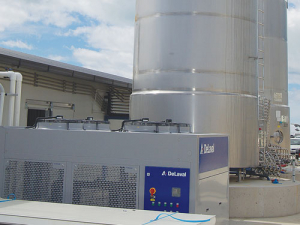A plate heat exchanger (PHE) is the most effective means of cooling milk, says DairyNZ.
But if your current plate heat exchanger and refrigeration unit combination are not capable of meeting the new milk cooling regulations you may need to consider a secondary cooling option.
A PHE consists of a series of very thin stainless steel plates. Water flows along one side of each plate while milk flows along the other. Heat is transferred from the milk to the water via the plate. The capacity of a plate cooler is adjusted by adding or subtracting plates.
The easiest way to check the effectiveness of the plate cooler is to compare the difference between the incoming temperature of the cooling water and the outgoing temperature of the milk leaving the plate cooler.
DairyNZ says an efficient PHE should cool milk to within 2°C of the water temperature before it enters the PHE. For example, if the temperature of the incoming cooling water is 14°C, the temperature of the milk exiting the plate cooler should be about 16°C.
Vat refrigeration is another option. In refrigerated/direct expansion tanks the refrigerant is pumped into the jackets (evaporators commonly referred to as ‘dimple plates’) on the internal surfaces of the bulk milk tank.
Here the refrigerant expands as it takes heat from the milk, is pumped out of the jackets, compressed then pushed into the condenser. The hot refrigerant is cooled by air (or water) flowing through the condenser fins. The cooled gas condenses into a liquid and is pumped back into the jackets around the bulk milk tank to start the cycle again.
Direct expansion has the disadvantage of maximum power draw during and after milking, which is generally peak rate. If large electric motors are used there can be problems in areas of poor power supply.
Direct expansion refrigeration systems are pressurised, which means they require a skilled technician for maintenance.
A secondary cooling option – necessary if your current plate heat exchanger and refrigeration unit combination are not capable of meeting the new milk cooling regulations -- may be costly and require a long payback period. But it may yield the benefit of heat recovery, enabling you to save on hot water costs.
DairyNZ advises farmers to carefully evaluate all options to ensure the system is fit for purpose without over capitalising.
Other options suggested by DairyNZ are;
Cooling towers
Cooling towers can very effectively cool water especially when humidity is low. Water can be cooled to within 5°C of the wet bulb temperature in a properly designed plant.
The most effective plants are fan forced and turn over a large store of water every hour. They operate overnight to cool a large water volume, usually 4½ times the volume of the daily milk yield.
Ice banks
Ice banks generate ice along evaporator coils using night rate power. The ice is used to chill water for the pre-cooler. The warm water is then returned from the pre-cooler to the top of the ice bank and cooled again as it runs down the ice.
Snap chillers
These use a refrigeration system to cool water or a food grade glycol/water mixture. Glycol systems tend to use a very small volume of fluid and create the chilled fluid on demand (at milking time).
Thermal stores
Thermal storage systems chill water using off peak power and require an insulated storage tank to hold a large (one day’s milking) volume of chilled water. Using more energy than a direct expansion tank, they have advantages in installation and maintenance.
Vat wraps
Vat wraps are only utilised by 20% of dairy farms in New Zealand but can save about 15-25% of milk cooling costs. They insulate milk from outside temperatures, preventing it from heating up and reducing energy used by the refrigeration unit.


















